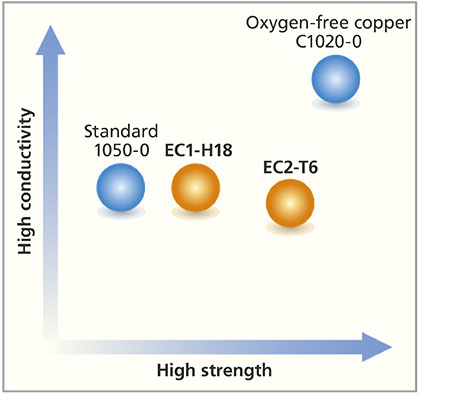Material Substitution
Recommendations for Replacing Copper Components with Aluminum AlternativesFor busbars
Copper is typically used in busbars, which are an essential component in power distribution boards. UACJ supplies a variety of aluminum alloys as an alternative to copper, which feature high strength and high conductivity. While demonstrating the performance demanded, they achieve a significant reduction in weight, leading to cost savings.
Features
- Aluminum busbars weigh less and cost less than copper busbars.
- The EC1 alloy offers the same high conductivity of pure 1050-O aluminum and with1.5 times the strength.
- While a busbar made of EC2 has only 57% of the conductivity of one made of copper, equal conductivity can be achieved by increasing the thickness of the EC2 alternative to 1.8 times that of the copper product.
Types and Properties
Aluminum busbars are 45% lighter and cost less than ones made of copper.

Comparison of aluminum and copper
* Calculations are based on the following raw material price indices for aluminum and copper, respectively: Nikkei average (January 2015) and domestic electrical copper quotes (January 2015 average).
| Material | Specific gravity | Conductivity (%ⅠACS) |
Relative weight of equivalent conductors | Raw material price indices* |
|---|---|---|---|---|
| Aluminum | 2.7 | (60) | 0.5 | 20 |
| Copper | 8.9 | 100 | 1 | 100 |
Mechanical characteristics and conductivity of busbar alloys
| Alloy | Tensile strength (N/mm2) |
Proof stress (N/mm2) |
Elongation (%) |
Conductivity (%ⅠACS) |
|---|---|---|---|---|
| EC1-H18 | 130 | 125 | 6 | 61 |
| EC2-T6 | 205 | 180 | 10 | 57 |
| 1050-O | 85 | 40 | 46 | 61 |
| C1020-O | 240 | 200 | 47 | 100 |


